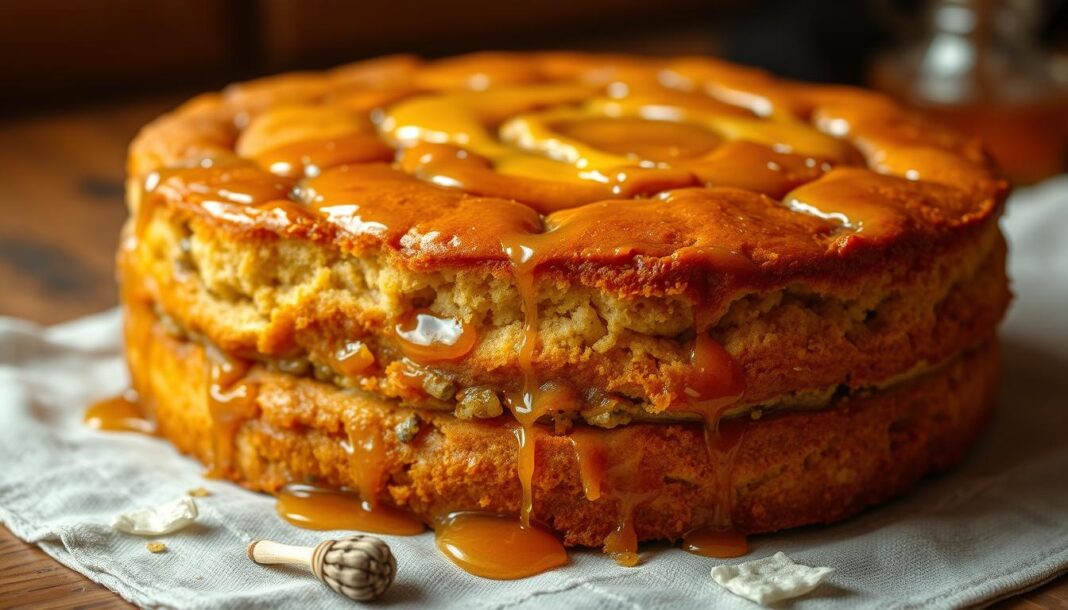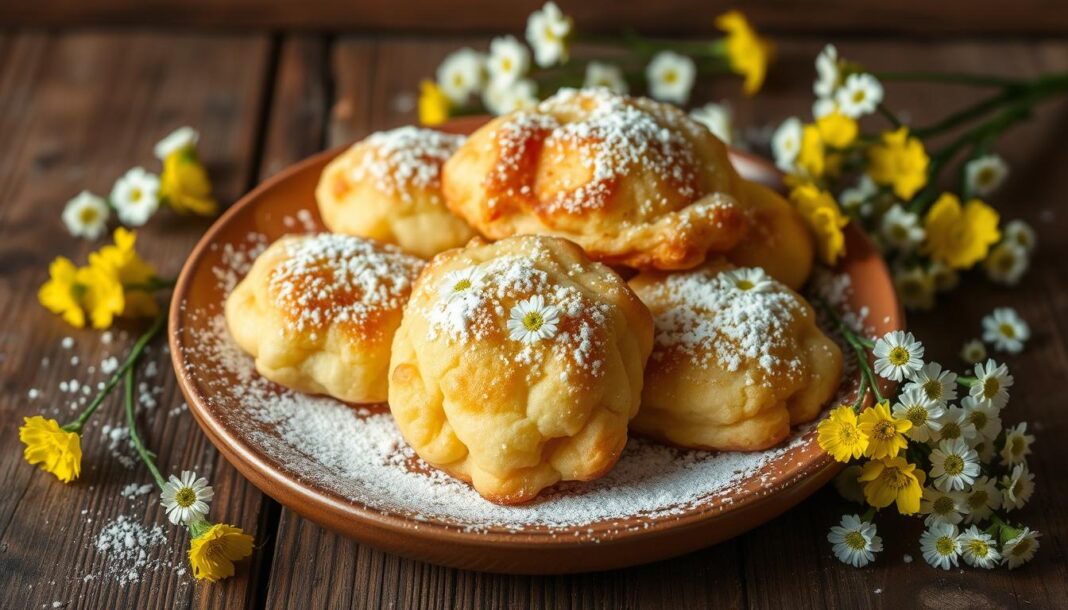The allure of ancient desserts lies not just in their taste but in the stories they tell about our culinary past. Honey cakes, in particular, have a rich history that spans thousands of years, with roots tracing back to the ancient Near East.
According to culinary historian Gil Marks, the earliest cakes were likely made from mashed legumes and honey, a sweetener that was both precious and plentiful in ancient times. The use of honey in baking continued through the ages, influencing the development of various desserts, including the cakes of medieval Europe.
We will embark on a journey to rediscover the original flavors of a medieval honey cake, exploring how these ancient desserts were made and what they reveal about the lives of our ancestors. By examining historical recipes and cooking techniques, we aim to bring the past to life, one dessert at a time.
Key Takeaways
- Explore the historical significance of honey cakes in medieval cuisine.
- Understand the role of honey as a primary sweetener in ancient baking.
- Discover how medieval bakers created desserts with limited ingredients.
- Learn about the cultural and social contexts of medieval desserts.
- Get a reconstructed medieval honey cake recipe adapted for modern bakers.
The Ancient Origins of Honey Cakes
The story of honey cakes begins in the ancient world, where they were first crafted with honey-sweetened yeast dough. This early cake was more than just a sweet treat; it was a culinary staple that traveled through time and geography, adapting to various cultures along the way.

From Ancient Egypt to Medieval Europe
Honey cakes originated in ancient Egypt, where they were made with honey, a valuable commodity. The Romans later adopted and adapted these recipes, creating variations that included barley, honey, raisins, and pine nuts. These early cakes were denser and more bread-like than their modern counterparts but were cherished for their sweetness in a world before refined sugar.
- The use of honey as a primary sweetener was a hallmark of these early desserts.
- The texture of these cakes was often more akin to dense bread.
How Honey Cakes Spread Throughout Europe
The spread of honey cakes throughout Europe is attributed to the Arabs, who introduced them to Spain and Sicily. By the 11th century, Italians were baking dense cakes from honey and bread crumbs. Italian Jews played a crucial role in disseminating these recipes to central and western Europe. The first known reference to honey cake in a western European Jewish context appears in the Machzor Vitry by Simcha ben Samuel of Vitry, France, in the late 11th century. For more on the historical significance of honey cakes, visit our page on honey cake history.
As honey cakes traveled, they became embedded in multiple cultural traditions, reflecting the culinary exchange and adaptation that occurred over time. A bit of this rich history is preserved in the various recipes and traditions that continue to celebrate these sweet treats.
Cultural Significance of Medieval Honey Cakes
The cultural significance of medieval honey cakes extends far beyond their role as a sweet treat. These cakes were intricately woven into the fabric of medieval society, particularly within Jewish communities across Europe. They played a crucial role in various ceremonies and celebrations, symbolizing the connection between food, culture, and tradition.
Honey Cakes in Jewish Traditions
In Jewish traditions, honey cakes were a staple during various celebrations. One notable ceremony was the Aleph-Bazyn, held for young boys on their first day of school. During this ceremony, a honey cake bearing inscriptions from Prophets and Psalms was served, symbolizing the sweetness of learning and knowledge. The ritual involved smearing honey on a slate with Hebrew letters, which the child would lick, creating a powerful sensory association between sweetness and education.
The Aleph-Bazyn Ceremony and Other Celebrations
The Aleph-Bazyn ceremony was not the only occasion where honey cakes played a significant role. They were also featured in engagement ceremonies and other festive occasions throughout eastern Europe. The tradition of serving honey cakes during these events highlighted their importance in reinforcing cultural identity and transmitting traditions across generations.
To better understand the significance of honey cakes in medieval times, let’s examine their role in various celebrations:
| Celebration | Role of Honey Cakes | Significance |
|---|---|---|
| Aleph-Bazyn Ceremony | Served with inscriptions from Prophets and Psalms | Symbolized the sweetness of learning and knowledge |
| Engagement Ceremonies | Featured as a sweet treat | Reinforced cultural identity and joyous celebration |
| Other Festive Occasions | Shared among community members | Fostered community bonding and cultural heritage |
For more information on medieval honey cakes and their recipes, you can visit our page on honey cakes.
Authentic Medieval Honey Cake Recipe
Reconstructing a medieval honey cake recipe requires a blend of historical research and culinary expertise. We start with a 13th-century formula that provides a foundation for our modern interpretation.
Understanding the Original Ingredients
Medieval bakers used ingredients that were readily available in their time, which often differed significantly from what we use today. The original recipe calls for “fine flour,” which likely referred to a type of flour milled from wheat or other grains available during the medieval period. Flour was a staple ingredient, and its quality varied based on the milling process.
The recipe also includes honey, a primary sweetener in medieval baking, as sugar was expensive and not widely available. Other key ingredients are oil and milk, which could be dairy or plant-based, reflecting the dietary preferences and restrictions of the time.
- Fine flour (likely wheat or other grains)
- Honey as a primary sweetener
- Oil (such as walnut, hazelnut, or poppy seed oil)
- Milk (dairy or plant-based)
Reconstructing Medieval Measurements
One of the challenges in recreating historical recipes is translating medieval measurements into modern terms. The original recipe mentions “three measures of fine flour” and “one measure of honey,” but the exact quantities are unclear. Through historical research and culinary experimentation, we’ve developed a recipe that balances these ingredients.
Our version uses 3 cups of cake flour, 1 cup of honey, ½ cup of oil, and ½ cup of milk. These measurements provide a starting point for achieving the right consistency and flavor.
Step-by-Step Preparation Instructions
To prepare the medieval honey cake, preheat your oven to 350°. Line the bottom of a 9″ round cake pan with parchment paper and oil the interior. In a large bowl, mix together the flour and honey until reasonably combined. Then, mix in the oil, followed by the milk, until the batter reaches a consistency similar to Play-Doh.
Spread the batter into the prepared pan, smoothing the top with a spatula. Bake for 35-40 minutes, or until the cake is done. This cake is best served warm, offering a dense, scone-like texture characteristic of medieval baking.
By following these steps and using ingredients that reflect medieval practices, we can create a cake that not only tastes delicious but also connects us to the culinary traditions of the past.
Tasting the Flavors of the Past
In the dense, honey-rich texture of this medieval cake, we find a connection to the past that’s both surprising and delightful. As we explore the flavors and textures of this authentic medieval honey cake, we’re struck by the simplicity and profundity of the ingredients.
The predominant flavor, as expected, is honey, which defines the entire eating experience. Unlike modern cakes with complex flavor profiles, this medieval recipe lets the purity of honey shine through. We’ve found that using high-quality honey makes a significant difference, as it enhances the overall flavor without adding unnecessary complexity.
The texture of this medieval honey cake is notably dense and scone-like, a characteristic typical of pre-modern baking techniques. This density led early authorities to categorize honey cakes closer to bread than to what we consider cake today, especially when they contained no spices. For more insights into historical food traditions, you might be interested in exploring our content on fantasy meals.
Tasting these historical recipes is more than just a culinary exercise; it’s a direct link to the daily life and pleasures of medieval people. Through this recipe, we gain insights into the past that texts alone cannot provide, making the experience both enlightening and delicious.


